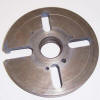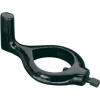| |
|
|
Advantages
turning between centres |
Disadvantages turning between centres |
- Work can be removed for
checking and re-set with no loss of centricity
- Work can be transferred
among machines with no loss in centricity
- Can turn work around with
no loss in centricity
- Long shafts can be
machined, using the full length of the bed
- Easy to setup
|
- Cutting speed effected id
revolving centre is not used in tailstock
- Centre holes must be
drilled before work can be set
- Boring, drilling, reaming
processes can not be performed
- Vibration due to dog
carrier
- Long shafts can bend
without lathe steadies
- Only relative small cuts
can be performed due to limited clamping power
of the dog carrier
- Need considerable
pressure to keep centres in position
|
|
https://www.youtube.com/watch?v=xEXXoT9asME |
|
|
Steps to follow when turning between
centres:
|
|
|
- Drill each end of the
shaft with centre holes
- Mount catch plate
(driving plate) in headstock spindle
- Place soft dead centre in
headstock spindle
- Place revolving centre in
tailstock (can use dead centre but need to be
lubricated regularly)
- Select correct size dog
carrier and place on workpiece
- Use shim stock between
dog carrier bolt and workpiece. This is
not to damage work.
- Make sure the leg of dog
carrier is making proper contact with catch
plate
- Stet spindle speed
correct
- Select correct feed for
the operation
|











